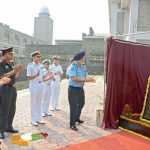Air Action over Daman and Diu
An engagement that knocked the wind out of the Portuguese
Early morning on Monday, 18 December 1961 a 26-year old flight lieutenant of the Indian Air Force, Palamadai Muthuswamy Ramachandran, took off in his Vampire Mk 52 aircraft from Jamnagar, Gujarat, headed for Diu 215 kilometres south. Flying as his wingman was Flying Officer Bhavani ‘Boondi’ Shankar with another Vampire. The two young officers, posted at the Pilot Attack Instructors’ School (PAIS) at Jamnagar then, were on their very first combat mission, the Indian armed forces having on that day launched ‘Operation Vijay’, the tri-services operation to oust the Portuguese from Goa, Daman and Diu, the last remaining colonial bastions in India. The two aircraft were armed with four 60-pound Medium Rocket Projectiles (MRPs) each under their wings and four Aden 20 mm cannons each loaded with 100 rounds of ball ammunition per gun. Their mission: offensive reconnaissance and close air support to the ground troops and naval vessels.
Arriving at the operational area over Diu they were assigned by the FAC (Forward Air Controller coordinating air support with the local army command) to attack some bunkers housing Portuguese guns that covered a causeway between the island and the mainland to the north, the only passage for our troops to advance. They attacked the bunkers with rockets causing considerable damage to them and with more such attacks by other sections following them the target was soon neutralized. Finding that a lot of ammunition was still left with them Flight Lieutenant Ramachandran sought a secondary target from the FAC. The response he got was to target Diu Town which was rather odd since it had no tactical significance and an attack on it had the grave potential of harming the civilian population. The officer chose to ignore it and flew around for a while on the look out for a proper military target.
It wasn’t long before he caught sight of a medium-sized patrol boat emerging from the fort on the eastern side of the island and heading fast southwestward. There was an Indian warship (which he would later learn was INS Delhi) standing about two miles offshore in that direction and it was apparent that the patrol boat was speeding towards it. To identify whether the boat was friendly or hostile Ramachandran descended to 200 feet and closed in on it flying from east to west when it opened fire on him with the fort guns keeping company with it. The clear trail left by the tracer bullets the Portuguese had interspersed in their gun ammunition left him with no doubt that he was under enemy fire. Too late to return fire he passed over westward unharmed; so did his No.2.
Promptly declaring the target as hostile the officer chose to attack. He planned to execute the attack heading towards the northeast so that he could avoid flying over the gun emplacements of the fort and, if his aircraft was hit, he might be able bail out over land in Indian territory behind our army lines. He turned around in a left-hand circuit going over the sea at low level and went into a steep pull-up attack rolling in towards the target in a 10 – 12 degree dive. Even as the patrol boat did evasive zigzagging whilst firing its guns, he held his aim steady and hit the target with a long burst from his guns. Turning around once he was away at a safe distance he saw the boat had gone static but had not been destroyed. Since the two aircraft of his section came from a training fleet it carried no HE (High Explosive) ammo and the ball ammunition with no explosive content had its limitations. His only chance to destroy the target, he reckoned, lay in pressing home another attack. His fuel gauge told him he had time enough to squeeze in one more quick attack. Using a tighter attack pattern he started firing at a slightly longer distance keeping all four guns blazing till he pulled out of the dive. The target being static had made his aiming easier and he managed to put the whole burst right into the target. Glancing back after the pull-out he saw a huge column of smoke rising mushroom-like from where the boat had been and wondered why there was such a massive explosion.
The wingman keeping up well with the leader all through the exploit the two pilots made it back safely to the base before their fuel ran out and with negligible damages to the aircraft. Although Flight Lieutenant Ramachandran was to carry out one more sortie the next day it turned out to be uneventful with the enemy resistance fading. The operation itself was over in 40 hours since its commencement with the Portuguese Governor General Manuel Antonio Vassalo de Silva surrendering to the Commander of the Indian Forces Major General K P Candeth at 2030 hours on 19 December. The 451-year old Portuguese rule of Goa had come to an end.
After-action reports based on prisoner interrogations ascertained that the Portuguese patrol boat laden with explosives (cause for its explosion) was indeed on a mission to ram INS Delhi which could have been a mighty blow for India. Portuguese papers published later identified the sunken vessel as “N.R.P. Vega” a micro warship equipped with a 20 mm cannon with a crew of eight. The vessel commanded by Second Lieutenant Oliveira e Carmo of the Portuguese Navy was under orders to engage the Indian forces. Of the crew, three, including its commander, were killed in the encounter with the Indian aircraft leaving five survivors.
For Flight Lieutenant Ramachandran and his mates at the air base the day 19th December ended in a rather sad note with their much-liked “Chiefy”, Flight Sergeant Swamy, being fatally injured in a freak accident. Ramachandran was taxiing into the dispersal when, Swamy, standing on the grass shoulder of the taxiway signaling to the marshaller, was hit on his temple by the wingtip of the aircraft. His was the only fatality the base suffered in the operation.
Flight Lieutenant P M Ramachandran was decorated for his gallantry with Ashok Chakra – Class III; the only gallantry award to be won by IAF in the operation. In an illustrious career that spanned nearly four decades he rose to the rank of Air Marshal and was the Vice Chief of Air staff at the time of his retirement in 1993. In addition to the Shaurya Chakra (as Ashok Chakra – Class III was subsequently renamed) he is also a recipient of the Vayu Sena Medal, the Ati Vishist Seva Medal and Param Vishist Seva Medal. He currently lives in Chennai.
[Adapted from the article “The sinking of N.R.P.Vega – a first person narrative” by the protagonist, Air Marshal P M Ramachandran PVSM AVSM SC VM (Retd), published in the Bharat Rakshak Website. Please follow the link below to read the original article in full]http://www.bharat-rakshak.com/IAF/history/1961goa/1352-p-m-ramachandran.html





